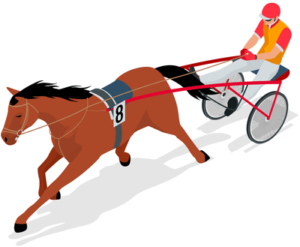 Mention horse racing to even those with only a passing interest in sport in general and they’ll likely tell you about the Grand National or the Cheltenham Festival. Few will know much about harness racing, however, though it’s possible that they’ll have seen examples of it on TV shows like Billions. It finds its origins in the chariot racing of old, which most will know if they’ve watched films like Gladiator or Ben-Hur.
Mention horse racing to even those with only a passing interest in sport in general and they’ll likely tell you about the Grand National or the Cheltenham Festival. Few will know much about harness racing, however, though it’s possible that they’ll have seen examples of it on TV shows like Billions. It finds its origins in the chariot racing of old, which most will know if they’ve watched films like Gladiator or Ben-Hur.
As the name suggests, this involves horses pulling carriages along thanks to harnesses. The carriages are known as sulkies and tend to house the jockeys rather than seeing them sit on the back of the horse. Even with the driver and sulky needing to be pulled along the horse can reach speeds of up to 30 miles per hour, so don’t be thinking that this is some sort of sedate experience compared to the racing you might be used to watching.
The biggest difference between this and thoroughbred racing is that the horses must run at either a trot or a pace, dictated by the race they’re in. The sport is popular in Australia, New Zealand, he US, South America, Canada and parts of southern and western Europe.
Best Bookmaker For Trotting/Harness Racing
Bet365

For more option than just betting on who will win a race you need to choose a bookie with serious depth when it comes to all forms of racing, they don't come much better than Bet365 when it comes to this.
Bet365 provide markets for all major harness racing, although note that they list all lines under trotting. You can also get access to more exotic bets with them, such as pool betting like Quinellas and Exatas.
The site also has all the form and stats you need to find your way around the markets.
Betting On Harness Racing
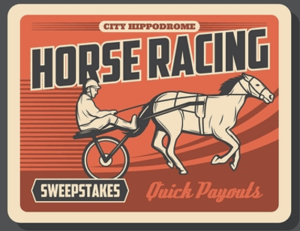 Despite its popularity around the rest of the world, harness racing still isn’t all that well known in the UK. As a result, not all bookmakers offer odds on harness races and those that do won’t always give you the best odds. Once you’ve found one that does, though, you’ll want to think about the type of race first and foremost. The 4 basic types of race in harness racing are as follows:
Despite its popularity around the rest of the world, harness racing still isn’t all that well known in the UK. As a result, not all bookmakers offer odds on harness races and those that do won’t always give you the best odds. Once you’ve found one that does, though, you’ll want to think about the type of race first and foremost. The 4 basic types of race in harness racing are as follows:
- Claiming Races – These races allow the entrants to be claimed for a specific amount of money
- Breeders and Sires Stakes – In these races owners pay a fee to nominate their participant and then a regular fee to maintain their place in the race
- Conditioned Races – The age, sex and success of the horse will determine whether they’re allowed to take part in the event or not
- Invitational, Preferred or Open Races – These races tend to be for the fastest horses around and horses tend to be invited to take part in them, apart from Open Races
There are slightly different bet types available in harness racing than standard horse racing, with the following being the most common:
- Win – A bet on the horse winning the race
- Place – Will the horse finish in the places allotted by the bookmaker?
- Show – As long as your horses finishes in the top 3 places you’ll win money
- Daily Double – Can you select the 2 winners of 2 consecutive races?
The History Of Harness Racing
Hails From The Assyrian Kings
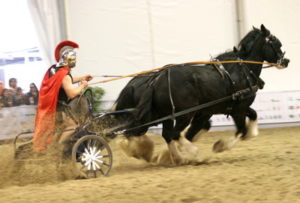 As you might expect, the sport of harness racing finds its origins in the chariot racing of old. Taking place in ancient Greece, Roman and Byzantine times, chariot racing was immensely popular in its day.
As you might expect, the sport of harness racing finds its origins in the chariot racing of old. Taking place in ancient Greece, Roman and Byzantine times, chariot racing was immensely popular in its day.
It was included in the original Ancient Olympic Games and differed from the modern sport on account of the fact that it involved both 2 and 4 horses pulling the chariot. It remained popular until around the 7th century, at which point the decline of the Byzantine Empire coincided with the decline of both the economy and the population.
The sport can trace its origins back even further than that, with Assyrian Kings having stables for horses that would pull chariots both for sport and for use in war as far back as 1500 BC. Indeed, Homer’s Iliad featured a story of a chariot race and that typically dates to around 1200 BC.
The modern form of the sport traces its origins to the rather more recent time of the 18th century, with a race in Holland known as The Golden Whip dating back to 1777 and involving trotting rather than outright running. It was in the 19th century that trotting began to be taken seriously as a sport, particularly in North America.
The Sport Becomes More Established
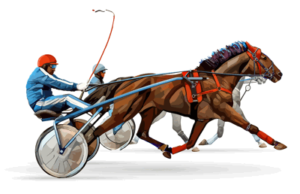
Trotting matches had been taking place in Holland since 1554, but it was the creation of The Golden Whip that gave the sport more prestige. It emerged at the same time that Count Orlov in Russia began to create a strain of trotters at his stud farm that would go on to form the basis of the sport in Russia, whilst the Norfolk Trotter began to be seen as a good horse for road racing in England.
It’s road racing that helped to create trotting in North America, too. There were trotting tracks throughout the United States by the start of the 19th century, with one of the famous ones being in Harlem, New York. There a trotting horse named Yankee set the record by trotting the course in 2 minutes and 59 seconds, though this time came down in the years that followed. Harness racing began to develop by the middle of the century, with trotting having become an established sport by 1840.
The Grand Circuit & The Standardbred
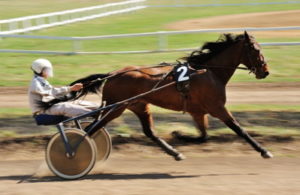 Arguably the biggest impact on harness racing as a sport occurred in 1871 when the Grand Circuit was founded. The oldest continuing harness-racing event in the United States began life as a competition called the Quadrilateral Trotting Combination. Its first meetings took place in 1873 at courses in New York, Utica, Cleveland, Springfield and Buffalo, growing to be hosted at over 20 tracks nowadays.
Arguably the biggest impact on harness racing as a sport occurred in 1871 when the Grand Circuit was founded. The oldest continuing harness-racing event in the United States began life as a competition called the Quadrilateral Trotting Combination. Its first meetings took place in 1873 at courses in New York, Utica, Cleveland, Springfield and Buffalo, growing to be hosted at over 20 tracks nowadays.
The creation of the Grand Circuit was followed by the breeding of what became known as the standardbred horse, which was based on a standard performance time of 2 minutes and 30 seconds. This was established in 1879 and became as influential on harness racing in the US as thoroughbreds were on flat racing in the UK.
Nowhere can this be seen more clearly than in the English thoroughbred Messenger. Imported into the States in 1788, he sired 10 sons that went on to become the leading sires in trotting in America in the 19th century.
Trotting Spreads Around The Rest Of The World
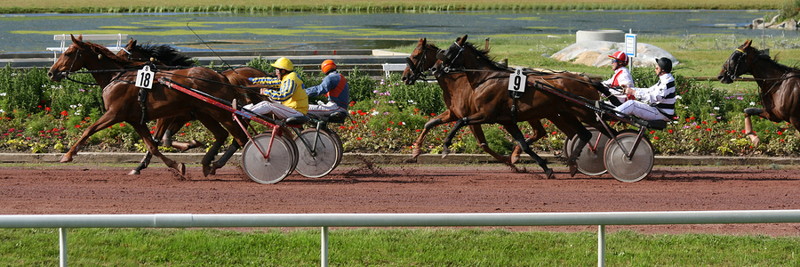
Trotting was introduced to France in 1836, with Italy boasting cart racing since the start of the 19th century. The introduction of the French blood stock to the sport saw its popularity increase, with Belgium, Holland and Sweden all having harness racing by the 1880s. Austria and Germany followed suit before the turn of the century, with the United Kingdom being the only major European country not to take the sport to heart.
Nowadays Australia and New Zealand are 2 countries were trotting is the most popular, but they were late to take to this form of horse racing. Despite the fact that American stock was introduced to them both in the 19th century, it wasn’t really until the end of the 20th century that the sport began to take off. In the US, meanwhile, the great-grandson of Messenger, Hambletonian, sired more than 1,000 sons and daughters and become so influential on the sport that virtually all trotters in the States can be traced back to him.
The Sulky Is Invented
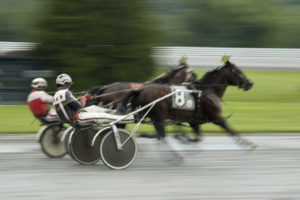 In the sport’s more formative years it could perhaps best be described as cart racing, because that’s exactly what the jockeys would sit in. Early in the 19th century the U-shaped sulky was introduced for the first time, weighting about 56 kilograms. This was rescued to more like 21 kilograms by the 1870s, but the developments to the vehicle didn’t stop there.
In the sport’s more formative years it could perhaps best be described as cart racing, because that’s exactly what the jockeys would sit in. Early in the 19th century the U-shaped sulky was introduced for the first time, weighting about 56 kilograms. This was rescued to more like 21 kilograms by the 1870s, but the developments to the vehicle didn’t stop there.
As the 1800s progressed the sulky had pneumatic tires and ball bearings introduced to it, with bicycle wheels replacing them in the 1890s. The drivers seat began to be lowered too, giving the device more aerodynamics. In 1903 Lou Dillon broke the 2-minute mile, which was bettered only 4 times until 1969. In part that record was down to the fact that the sulky that Lou Dillon carried weighed just 11.3 kilograms.
The Sport’s Decline And Renaissance
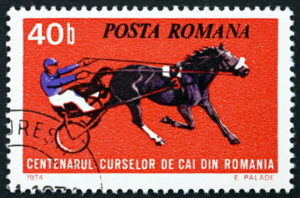 By the turn of the 20th century harness racing was immensely popular, boasting large attendances and the horses themselves having fans. Though it remained popular in Europe as the century progressed and the Grand Circuit still had plenty of supporters, harness racing’s popularity began to die down as the 20th century progressed. It wasn’t until Roosevelt Raceway in New York City began to offer pari-mutuel betting under the lights in 1940 that the tide started to turn.
By the turn of the 20th century harness racing was immensely popular, boasting large attendances and the horses themselves having fans. Though it remained popular in Europe as the century progressed and the Grand Circuit still had plenty of supporters, harness racing’s popularity began to die down as the 20th century progressed. It wasn’t until Roosevelt Raceway in New York City began to offer pari-mutuel betting under the lights in 1940 that the tide started to turn.
As betting under the lights started to entice a new audience, the invention of the mobile starting gate in 1946, which allowed an even running start for all horses, sae the sport began to regain its place in the public consciousness. In the decades after that the attendance at harness racing in the US virtually tripled, seeing similar expansions in New Zealand, Australia and in Europe.
Nowadays there are major centres for harness racing in the likes of Chicago and Los Angeles as well as Toronto and Montreal. Some of the sport’s biggest competitions were created in the 20th century, proving it’s a modern sport if anything.
Harness racing’s growth continued into the 1980s, with a pace race at Meadowlands at the start of that decade being worth more than $2,000,000 in prize money. Problems began to arise when the amount of money involved in the sport saw over-racing of horses and drugs that should have been used for medical purposes instead being used to corrupt the sport. That’s not to suggest that things have slowed down all that much, simply that it has become a more regulated sport in recent times in order to combat these things.
Are Trotting & Harness Racing The Same Thing?
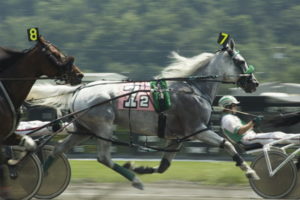 A quick note at this point to draw your attention to the fact that harness racing is sometimes referred to as trotting, especially by bookmakers. Indeed, you’ll note that we’ve already referred to trotting elsewhere on the page as though it’s the same sport as harness racing and that’s because it basically is.
A quick note at this point to draw your attention to the fact that harness racing is sometimes referred to as trotting, especially by bookmakers. Indeed, you’ll note that we’ve already referred to trotting elsewhere on the page as though it’s the same sport as harness racing and that’s because it basically is.
We’ll explain in this next section the difference between the two types of harness races, of which trotting is one. The only thing that you need to know at this stage is that if you see a bookmaker referring to ‘trotting’ on their pages then they mean the type of harness racing event in which horses trot, as opposed to the one in which they pace.
How Harness Racing Works
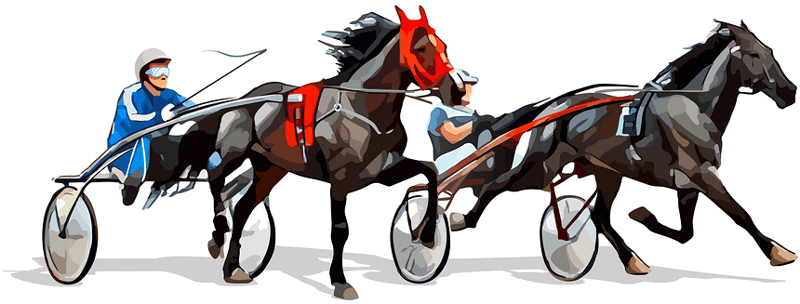
There are 2 different types of harness racing: trotting and pacing. Trotting is a natural thing for horses to do, with front and back legs working in harmony with each to demonstrate a balanced gait. Pacing, on the other hand, goes against a horse’s every instinct and involves the front and back legs on each side of the horses moving in tandem with each other. This type of movement needs to be trained into a horse from an early age and is therefore specialised.
The racing takes place around and oval track and the horses pull the 2-wheeled sulky behind them. Typically the races are run over distances of between half a mile and a mile, with judges watching to see whether any of the horses break their stride during the race. If a horse that it supposed to be a pacer breaks into a trot, even for a moment, then they will be disqualified.
When it comes to the sort of horses that can take part in harness racing, it is limited to Standardbreds in the United States to the exclusion of thoroughbreds. These are tougher horses that typically tend to have a calmer temperament.
The minimum age limit on horses involved in harness racing is limited to 2 years of age, though there is no upper limit. Ideally horses will take part in harness racing no more than once a week, though this is limited more by the number of races available within a particular class than anything to do with the horse’s ability.
It is possible for riders to ride saddled on trotters in certain races, though this tends to be limited to European harness racing. The French call is trot monté. European races also have a more relaxed attitude to the breed of horse taking part, with trotters commonly allowed to race alongside Standardbreds. Continental Europe tends to see the type of races that take place limited to trotters, with pacer races being more common in America, Australia, Canada and New Zealand.
In harness racing, horses are put into classes depending on how much money they’ve won. In the UK a single win sees the horse become a Grade 1 competitor, with movement through the rest of the Grades up to 12 being determined by the money they’ve won. Horses can also be classified as follows:
- Class III
- Class II
- Class I
- Bronze
- Silver
- Gold
Mares can be put into a 7th Class as well as in any of those listed above.
The way that harness racing races start can seem confusing. It’s typical in the United States to use a mobile starting gate, which drives around the course with the horses behind it before the gates are lifted up and the car accelerates away.
Another starting method is known as the circular starting system, which sees horses moving around the course in 2 different waves until they are all up to speed. Their starting position within these waves can determine how well the begin the race.
The Biggest Races In Harness Racing
| Race | Venue | Information |
|---|---|---|
| Prix d’Amérique | Hippodrome de Vincennes (France) | Generally considered to be the pre-eminent harness racing event, the Prix d’Amérique first took place in 1920. It is run on the final Sunday in January every year. |
| Solvallas Internationella Elitlopp | Solvalla Racetrack (Sweden) | Better known simply as the Elitloppet, which translates as ‘Elite Race’, this is an invitational harness race for Group 1 horses. It was first run in 1952 and is one of trotting’s most prestigious events. |
| Swedish Trotting Derby | Jägersro Racetrack (Sweden) | Inaugurated in 1928, this annual event for Group 1 trotters is one of the most important races for 4-year-old Swedish horses. |
| Hambletonian Stakes | Meadowlands Racetrack (USA) | Named in honour of one of the most important sires in Standardbred horse breeding, Hambletonian 10, this race was first run in 1926 and is part of the Triple Crown of Harness Racing for Trotters. |
| Little Brown Jug | County Fairgrounds (USA) | This race is for 3-year-old pacers and has been taking place since 1946. It’s named after the horse Little Brown Jug, which was made a USTA Hall of Fame Immortal in 1975. |
| Inter Dominion | Various (Australia and New Zealand) | Contested since 1936, the Inter Dominion is a competition rather than a one-off race. |
| Miracle Mile Pace | Menangle Park Paceway (Australia) | First run in 1967, this race for Standardbred pacers is one of the most expensive races in Australian harness racing. |
| Auckland Pacing Cup | Alexandra Park (New Zealand) | Held on New Year’s Eve and inaugurated in 1890, this is a Group 1 race that takes place over 2700 metres and is one of the country’s most important events. |
| Gran Premio Lotteria | Agnano Racetrack (Italy) | Run over 1,600 metres and for trotters aged four and over, the Lotteria first took place in 1951. It is one of trotting’s most prestigious events internationally and is part of the European Grand Circuit. |
As you might imagine, harness racing is a somewhat specialist sport. As a result, there are a number of top events that harness racing horses are limited to taking part in. The table above looks at the main ones.
This list is far from exhaustive and doesn’t include major meetings such as the Grand Circuit in America and the Inter Dominion in Australia and New Zealand. It gives you some idea, though, of the level of racing in a sport that you may not have known much about before now.
